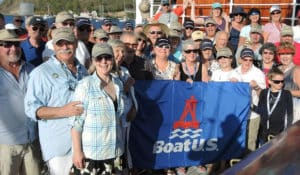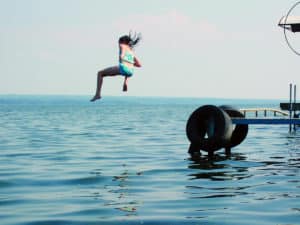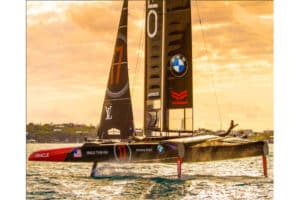Editor’s note: For yachtsmen who venture into the realm of commercial shipping, concerns about being run down at sea should be constant. All too often, though, a lack of vigilance or a poor understanding of the other guy creates a false sense of security on the water. Here, former ship’s officer and current large-yacht captain Michael Howorth takes a look at the issue from both sides.
If ever I am in danger of falling asleep on a long, dull night watch, I have only to think back and remember my worst fear: a collision or near collision of my yacht and a merchant vessel. Instantly, I am alert again. I know all too well how easily such collisions can happen. Years ago, when I served as a junior officer aboard a huge tanker, we steamed into the Persian Gulf and found the mast and sails of a tiny Arab dhow impaled on our starboard anchor. Though my ship was particularly well run with very conscientious watch keepers, we were unaware we had been involved in the overnight collision.
The fundamental issue is, of course, the keeping of a good lookout by every vessel, which is covered in Rule 5 of the COLREGS: “Every vessel shall at all times maintain a proper lookout by sight and hearing, as well as by all available means appropriate in the prevailing circumstances and conditions, so as to make a full appraisal of the situation and the risk of collision.
Failure to fulfill this basic requirement is a major cause of collisions. Good seamen always obey Rule 5, but we do not live in a perfect world. Some lookout standards, especially those aboard commercial ships, are poor. Do not blame just the watch officer on the bridge of a merchant ship, however. His job is demanding and, as Rule 5 states, every vessel has equal responsibility to keep a good lookout.
The officer of the watch is a very busy person, responsible for safe navigation, monitoring the radar, keeping an eye on other shipping, ensuring the routine business of the ship is properly conducted, observing and recording the weather, checking an increasing number of displays and instruments on the bridge and dealing with incoming satellite and radio traffic. Every alarm, no matter what its source, is a potential distraction.
Furthermore, ships that carry a large number of containers forward of the bridge can have a substantial blind zone ahead. If your yacht is very close ahead of a fully laden container ship, you must assume that whoever is on watch at the other end can not see anything small within perhaps 400 or 500 yards immediately ahead.
Last summer, I spent time piloting a large ferry across a crowded waterway used extensively by pleasure craft. The experience reinforced these problems. At night, I frequently encountered difficulty when trying to make out the navigation lights of small craft. Masthead lights are seen more easily than those fitted on the pulpit, which can be obscured by waves. The minimum range of most lights on a yacht is 2 miles; on a very small vessel, the range of sidelights is only 1 mile. In practice, navigation lights can be seen at greater distances, but it is difficult to pick out a lone sidelight, especially against shore lights, in sufficient time to do anything about it.
To increase your yacht’s visibility to radar, a reflector should be fitted. Merchant ship radars normally use ARPA (automated radar-plotting aid), a system that relies on detecting an echo over several sweeps to generate an automatic plot showing the course speed and closest point of approach of the other vessel. If the radar fails to detect the yacht, or hold contact for at least 50 percent of the time, ARPA will not provide the necessary information. Many fiberglass yachts have few radar-echoing areas and are detected only at relatively short ranges and often intermittently. Yachtsmen should undertake careful research before buying a reflector, bearing in mind the types of radars in use today. It is also essential that the radar reflector be properly fitted aboard your yacht.
Be prepared to enhance your yacht’s visibility at night. A bright-white light shone in the direction of a vessel on a collision course with yours will attract attention, but it can also detract from the watch officer’s ability to make out your navigation lights. If you’re aboard a sailing yacht, shine the light into your sails instead. A white anti-collision flare is also an excellent choice. It should be kept close to the wheel, ready for immediate use in the event of emergency (and of course, every watch keeper must know how to use it, too). One flare is probably not enough, since the other vessel’s watch keeper may have seen it only out of the corner of his eye and needs a better look.
No matter what attracts the attention of the watch officer, though, he needs time to recognize what he is looking at, assess the range and alter course (after ensuring he won’t putting his vessel in worse danger by doing so). His reaction is not instantaneous. Also, many commercial vessels have large turning circles, so few are able to stop quickly.
If the merchant-ship’s officer has problems, so do you, especially if you are on your own. Watch-keeping on a clear summer’s day is one thing. Watch-keeping on a foul night is quite another. You might be tired, bored, cold, wet, even seasick, and are looking forward to turning in. Your mind is in neutral, or your head is down and your hood pulled tight to keep out the rain. When it comes to situations like these, everyone occasionally fails to look around properly, especially when you’re away from the coast or a shipping lane. The temptation to leave the watch for “just a few minutes to plot a fix, heat some soup, listen to the weather forecast or write up the log is great. Such chores can indeed take just a few minutes, but more often they run closer to 20 minutes than three. A merchant ship doing 20 knots can go from being hull down on the horizon to being on top of you in less time than that, especially in reduced visibility.
So, before going off for a short spell, give thought to the prevailing conditions. If visibility is reduced, you must increase your alertness accordingly and reduce the time you spend away from your lookout. And remember: Danger can pop up at any time-a significant percentage of the world’s reported collisions between yachts and merchant ships occur in the emptiest parts of the ocean, where people generally pay the least attention.
Preventing a collision or close-quarters situation is among the most demanding challenges a yachtsman can face. Accurately judging distance at sea by sight is still one of the most difficult of all nautical skills to acquire. It takes a lot of practice to get it right, especially at night or in conditions of reduced visibility. Radar can help, but only if it is fully understood and properly used.









